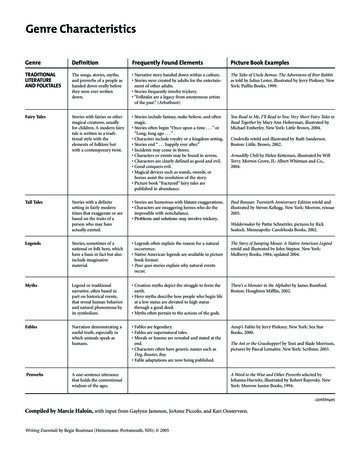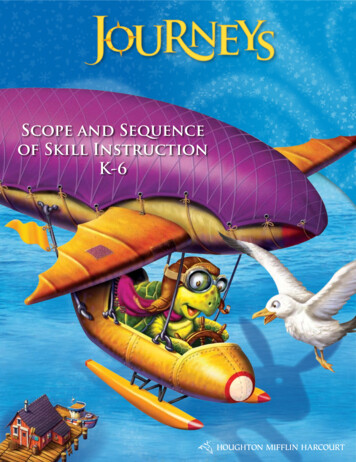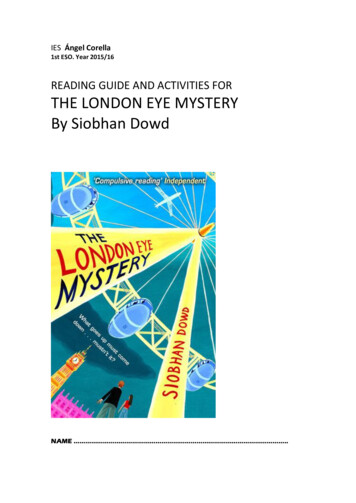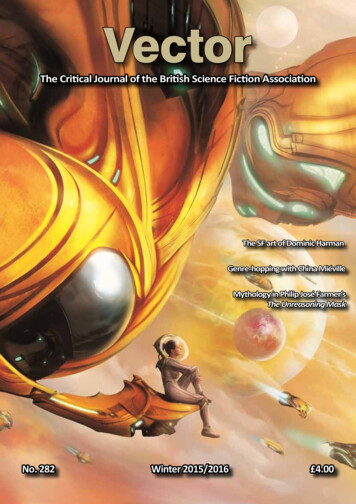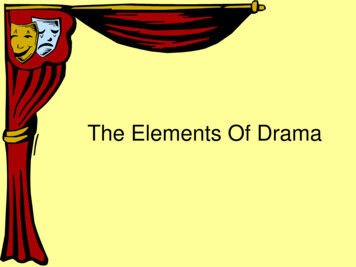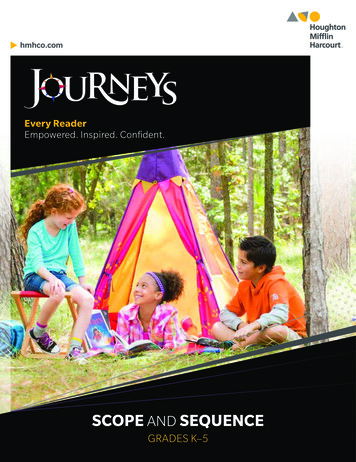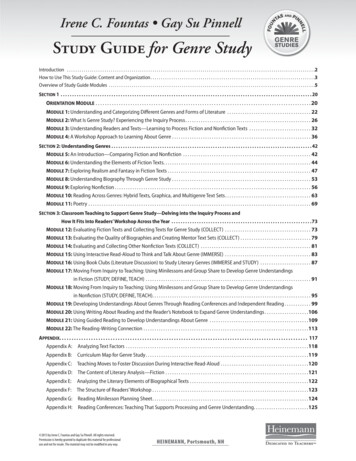
Transcription
Irene C. Fountas Gay Su PinnellStudy Guide for Genre StudyIntroduction . . . . . . . . . . . . . . . . . . . . . . . . . . . . . . . . . . . . . . . . . . . . . . . . . . . . . . . . . . . . . . . . . . . . . . . . . . . . . . . . . . . . . . . . . . . . . . . . . . . . . . . . . . . . . . . . . . . . . . . 2How to Use This Study Guide: Content and Organization . . . . . . . . . . . . . . . . . . . . . . . . . . . . . . . . . . . . . . . . . . . . . . . . . . . . . . . . . . . . . . . . . . . . . . . . . . . . . . 3Overview of Study Guide Modules . . . . . . . . . . . . . . . . . . . . . . . . . . . . . . . . . . . . . . . . . . . . . . . . . . . . . . . . . . . . . . . . . . . . . . . . . . . . . . . . . . . . . . . . . . . . . . . . . . . 5Section 1 . . . . . . . . . . . . . . . . . . . . . . . . . . . . . . . . . . . . . . . . . . . . . . . . . . . . . . . . . . . . . . . . . . . . . . . . . . . . . . . . . . . . . . . . . . . . . . . . . . . . . . . . . . . . . 20Orientation Module . . . . . . . . . . . . . . . . . . . . . . . . . . . . . . . . . . . . . . . . . . . . . . . . . . . . . . . . . . . . . . . . . . . . . . . . . . . . . . . . . . . . . . . . . . . . . 20Module 1: Understanding and Categorizing Different Genres and Forms of Literature . . . . . . . . . . . . . . . . . . . . . . . . . . . . . . . . . . . . . . . 22Module 2: What Is Genre Study? Experiencing the Inquiry Process . . . . . . . . . . . . . . . . . . . . . . . . . . . . . . . . . . . . . . . . . . . . . . . . . . . . . . . . . 26Module 3: Understanding Readers and Texts—Learning to Process Fiction and Nonfiction Texts . . . . . . . . . . . . . . . . . . . . . . . . . . . . . 32Module 4: A Workshop Approach to Learning About Genre . . . . . . . . . . . . . . . . . . . . . . . . . . . . . . . . . . . . . . . . . . . . . . . . . . . . . . . . . . . . . . . . 36Section 2: Understanding Genres . . . . . . . . . . . . . . . . . . . . . . . . . . . . . . . . . . . . . . . . . . . . . . . . . . . . . . . . . . . . . . . . . . . . . . . . . . . . . . . . . . . . . . . 42Module 5: An Introduction—Comparing Fiction and Nonfiction . . . . . . . . . . . . . . . . . . . . . . . . . . . . . . . . . . . . . . . . . . . . . . . . . . . . . . . . . . . 42Module 6: Understanding the Elements of Fiction Texts . . . . . . . . . . . . . . . . . . . . . . . . . . . . . . . . . . . . . . . . . . . . . . . . . . . . . . . . . . . . . . . . . . . 44Module 7: Exploring Realism and Fantasy in Fiction Texts . . . . . . . . . . . . . . . . . . . . . . . . . . . . . . . . . . . . . . . . . . . . . . . . . . . . . . . . . . . . . . . . . . 47Module 8: Understanding Biography Through Genre Study . . . . . . . . . . . . . . . . . . . . . . . . . . . . . . . . . . . . . . . . . . . . . . . . . . . . . . . . . . . . . . . . 53Module 9: Exploring Nonfiction . . . . . . . . . . . . . . . . . . . . . . . . . . . . . . . . . . . . . . . . . . . . . . . . . . . . . . . . . . . . . . . . . . . . . . . . . . . . . . . . . . . . . . . . . 56Module 10: Reading Across Genres: Hybrid Texts, Graphica, and Multigenre Text Sets . . . . . . . . . . . . . . . . . . . . . . . . . . . . . . . . . . . . . . . 63Module 11: Poetry . . . . . . . . . . . . . . . . . . . . . . . . . . . . . . . . . . . . . . . . . . . . . . . . . . . . . . . . . . . . . . . . . . . . . . . . . . . . . . . . . . . . . . . . . . . . . . . . . . . . . . 69Section 3: Classroom Teaching to Support Genre Study—Delving into the Inquiry Process andHow It Fits Into Readers’ Workshop Across the Year . . . . . . . . . . . . . . . . . . . . . . . . . . . . . . . . . . . . . . . . . . . . . . . . . . . . . . . . . . . . . 73Module 12: Evaluating Fiction Texts and Collecting Texts for Genre Study (COLLECT) . . . . . . . . . . . . . . . . . . . . . . . . . . . . . . . . . . . . . . . . 73Module 13: Evaluating the Quality of Biographies and Creating Mentor Text Sets (COLLECT) . . . . . . . . . . . . . . . . . . . . . . . . . . . . . . . . . 79Module 14: Evaluating and Collecting Other Nonfiction Texts (COLLECT) . . . . . . . . . . . . . . . . . . . . . . . . . . . . . . . . . . . . . . . . . . . . . . . . . . . 81Module 15: Using Interactive Read-Aloud to Think and Talk About Genre (IMMERSE) . . . . . . . . . . . . . . . . . . . . . . . . . . . . . . . . . . . . . . . . 83Module 16: Using Book Clubs (Literature Discussion) to Study Literary Genres (IMMERSE and STUDY) . . . . . . . . . . . . . . . . . . . . . . . . 87Module 17: Moving From Inquiry to Teaching: Using Minilessons and Group Share to Develop Genre Understandingsin Fiction (STUDY, DEFINE, TEACH) . . . . . . . . . . . . . . . . . . . . . . . . . . . . . . . . . . . . . . . . . . . . . . . . . . . . . . . . . . . . . . . . . . . . . . . . . . . . 91Module 18: Moving From Inquiry to Teaching: Using Minilessons and Group Share to Develop Genre Understandingsin Nonfiction (STUDY, DEFINE, TEACH) . . . . . . . . . . . . . . . . . . . . . . . . . . . . . . . . . . . . . . . . . . . . . . . . . . . . . . . . . . . . . . . . . . . . . . . . 95Module 19: Developing Understandings About Genres Through Reading Conferences and Independent Reading . . . . . . . . . . . . 99Module 20: Using Writing About Reading and the Reader’s Notebook to Expand Genre Understandings . . . . . . . . . . . . . . . . . . . 106Module 21: Using Guided Reading to Develop Understandings About Genre . . . . . . . . . . . . . . . . . . . . . . . . . . . . . . . . . . . . . . . . . . . . . 109Module 22: The Reading-Writing Connection . . . . . . . . . . . . . . . . . . . . . . . . . . . . . . . . . . . . . . . . . . . . . . . . . . . . . . . . . . . . . . . . . . . . . . . . . . . 113Appendix . . . . . . . . . . . . . . . . . . . . . . . . . . . . . . . . . . . . . . . . . . . . . . . . . . . . . . . . . . . . . . . . . . . . . . . . . . . . . . . . . . . . . . . . . . . . . . . . . . . . . . 117Appendix A: Analyzing Text Factors . . . . . . . . . . . . . . . . . . . . . . . . . . . . . . . . . . . . . . . . . . . . . . . . . . . . . . . . . . . . . . . . . . . . . . . . . . . . . . . . . . . 118Appendix B: Curriculum Map for Genre Study . . . . . . . . . . . . . . . . . . . . . . . . . . . . . . . . . . . . . . . . . . . . . . . . . . . . . . . . . . . . . . . . . . . . . . . . . 119Appendix C: Teaching Moves to Foster Discussion During Interactive Read-Aloud . . . . . . . . . . . . . . . . . . . . . . . . . . . . . . . . . . . . . . . . 120Appendix D: The Content of Literary Analysis—Fiction . . . . . . . . . . . . . . . . . . . . . . . . . . . . . . . . . . . . . . . . . . . . . . . . . . . . . . . . . . . . . . . . . 121Appendix E: Analyzing the Literary Elements of Biographical Texts . . . . . . . . . . . . . . . . . . . . . . . . . . . . . . . . . . . . . . . . . . . . . . . . . . . . . . 122Appendix F: The Structure of Readers’ Workshop . . . . . . . . . . . . . . . . . . . . . . . . . . . . . . . . . . . . . . . . . . . . . . . . . . . . . . . . . . . . . . . . . . . . . . . 123Appendix G:Reading Minilesson Planning Sheet . . . . . . . . . . . . . . . . . . . . . . . . . . . . . . . . . . . . . . . . . . . . . . . . . . . . . . . . . . . . . . . . . . . . . . 124Appendix H: Reading Conferences: Teaching That Supports Processing and Genre Understanding . . . . . . . . . . . . . . . . . . . . . . . . 125 2013 by Irene C. Fountas and Gay Su Pinnell. All rights reserved.Permission is hereby granted to duplicate this material for professionaluse and not for resale. The material may not be modified in any way.HEINEMANN, Portsmouth, NH
Study GuideIntroductionThis guide for instructors, staff developers, literacy coaches, and study groups provides suggestionsfor a series of professional development, or other study sessions, based on Fountas and Pinnell’s text,Genre Study: Teaching with Fiction and Nonfiction Books (Heinemann 2012). The modules vary from oneto three hours in length and may be combined for several all-day seminars or presented over a seriesof shorter periods. The modules are designed so that you can pick and choose sessions dependingon your interests and time availability.Purpose of Genre Study: Teaching with Fiction and Nonfiction BooksThe purpose of Genre Study: Teaching with Fiction and Nonfiction Books (2012) is to help teacherslearn an inquiry approach to genre study within a readers’ workshop. Through the inquiry approach,students will construct knowledge about genre that will help them think, talk, and read texts withdeeper understanding, as well as write effectively across different genres. On page 8 of Genre Study,the three goals of this book are stated:1. To build your expertise in understanding specific genres and their characteristics.2. To help you understand an inquiry process you can use with your students to study the char-acteristics of any genre.3. To show you how to help students apply their knowledge of genres in talking, reading, andwriting.The purpose of this study guide is to help you reach these overall goals through interactive, handson, and collaborative experiences.Content and Organization of Genre Study: Teaching with Fiction and Nonfiction BooksThe Genre Study book is divided into three different sections:2 Section 1 (Chapters 1–5): The first section is dedicated to developing an understanding ofthe inquiry approach to genre study within a readers’ workshop. Section 2 (Chapters 6–13): The chapters in this section are devoted to a detailed descriptionof the characteristics of fiction and nonfiction. This foundational body of understandings isdeveloped with students over long periods of time as they have rich experiences with a variety of texts across several genres; however, teachers will find it helpful to have some of theseunderstandings before beginning genre study to guide the inquiry process.introduction 2013 by Irene C. Fountas & Gay Su Pinnell
Study Guide for Genre Study: Teaching with Fiction and Nonfiction Books Section 3 (Chapters 14–20): Though all of the chapters of Genre Study have implicationsfor classroom teaching, the chapters in this section directly address instruction for genreunderstandings within a variety of instructional contexts for reading and writing, includinginteractive read-aloud and literature discussion, reading minilessons, independent readingand reading conferences, guided reading, and writing about readers’ and writers’ workshop.How to Use This Study Guide: Content and OrganizationThe modules in this study guide pull from the different sections of Genre Study to provide the mostcomprehensive and hands-on experience for participants in this study; they do not necessarily follow a sequential study of the chapters. Like the Genre Study text, the study guide is divided intothree sections. There are a number of modules within each section. Each module contains suggestions for professional development experiences that will allow participants to construct their ownunderstandings about genre and the process of genre study. You can follow the list of professionaldevelopment “activities” in the order they are listed in each module, or you can pick and choose theexperiences that you think fit the needs of your group and time constraints. Section 1: Understanding an Inquiry Approach to Genre Study and Supporting Readers in Processing Fiction and Nonfiction: The modules in this section provide an overview of the genre studyprocess and how it functions within a workshop approach to teaching reading and writing.It also provides an overview of the way texts are categorized into genres and how genreknowledge facilitates the reading process. Section 2: Understanding Genres: Like the chapters in Section 2 of Genre Study, the modulesin this section provide a detailed description of the characteristics of a variety of fiction andnonfiction modules. In many cases, participants will experience an abbreviated version of thegenre study process to construct their own understandings of different genres. Section 3: Classroom Teaching to Support Genre Study—Instruction to Support the Steps in theInquiry Process: The modules in this section provide insight into the different instructionalcontexts that support the steps in the genre study process: collect, immerse, study, define,teach, read and revise. It begins with a series of modules dedicated to the first step in thegenre study process—collecting good examples of different genres. The activities in Modules12–14 provide opportunities for colleagues to work together to evaluate and develop textsets to support classroom instruction and the inquiry process. Modules 15 and 16 focus onhow to immerse students in a genre through interactive read-aloud and literature discussion.Module 19 explores how to use independent reading as a time to further immerse studentsin a genre as they read and study self-selected books in a particular genre. Modules 17, 18,19, and 21 address how to use reading minilessons, reading conferences, and guided reading to teach more explicitly about the characteristics of genre that the students have noticedthrough the inquiry process. Lastly, Modules 20 and 22 explore how to use writing to helpstudents further construct their understandings of genre.The following chart provides a summary of each module and a list of materials needed to implementall of the professional development activities within the module.You will find more specific information about materials within the modules themselves. Time estimates are listed for each activity withina module, but the amount of time you spend will always depend on how much interaction you have 2013 by Irene C. Fountas & Gay Su Pinnellintroduction 3
Study Guide for Genre Study: Teaching with Fiction and Nonfiction Booksin your group. You may want to break the activities up to make them shorter or combine them forlonger professional development sessions.The modules also provide suggestions of how to integrate some of the optional resources that canbe used with Genre Study to help with everyday classroom teaching. These tools include the GenreStudy Quick Guide, Genre Prompting Guide for Fiction, and Genre Prompting Guide for Nonfiction, Poetry,and Test Taking.At the end of most modules, you will find a Classroom Connections section that provides suggestions for carrying the learning from your study sessions into the classroom. Classroom Connectionsalso often includes suggestions for follow-up readings.A Note About Assigning ReadingMany of the professional development activities described in the modules use an inquiry approachfor developing knowledge about different genres in the same way you would experience genre studywith your students. If participants read the chapters pertaining to the genre of study before the session, theinquiry process will not be as authentic. Therefore, you will want to think about which readings willenhance the experience for the participants if read ahead of time and which would be better readafter the inquiry experience to solidify and clarify ideas. The Participant Preparation section at thebeginning of each module will address reading that is recommended before the session, and theClassroom Connections section at the end of each module indicates which readings might be useful as a follow-up to the session. We have listed the chapters from Genre Study that would be usefulfor the group leader to read before each session in the sections labeled Group Leader Preparation.We recommend that you check the Participant Preparation section for the next module you plan toaddress as part of your planning for each session so you are able to tell participants ahead of timewhat they should bring, read, or prepare for the next session.Suggested Sequence of StudyOne suggested sequence of study is to complete all of the modules in Section 1 (the Orientation andModules 1–4); choose which genres you want to focus on from Section 2: Modules 6–11 (Modules 5,6, and 9 are the most general and provide overviews of the characteristics and elements of fiction andnonfiction); select which genre text sets you would like your colleagues to develop from Modules12–14; and choose the instructional contexts you want to focus on from Modules 15–22.4 introduction 2013 by Irene C. Fountas & Gay Su Pinnell
Overview of Study Guide ModulesModule Title and LengthMaterials, Readings, and OptionalResourcesOrientation ModuleParticipant Preparation:Chapters Addressed: Chapter 1;Section Overviews (pp. 1, 55, 215) Bring a list of the type of texts you readfor pleasure.Total Estimated Time: 1½ hours Bring Genre Study. Bring a reflection journal.Group Leader Preparation: Provide chart paper and markers. Read pp. 1, 55, 215, and Chapter 1 ofGenre Study.Goals To gain an overview of the layout andcontent of the Genre Study text. To gain an understanding of the purposeand goals of this book. To understand the definition of genre. To understand the role and value of genrein reading and writing. To gain an overview of an inquiryapproach to learning about genre usingmentor texts. To begin thinking about your own reading expectations based on genre.Module 1: Understanding andCategorizing Different Genresand Forms of LiteratureChapters Addressed:Chapters 3 and 15Professional DevelopmentActivities: Categorizing Genre and Formsof Literature (45 minutes–1 hour) Examining and CategorizingTexts Using Genre Categories(1 hour)Total Estimated Time: 2 hoursParticipant Preparation: Bring four or five books that you readaloud to your students. Bring Genre Study.Group Leader Preparation: Read Chapter 3 and Chapter 15 ofGenre Study. Bring an envelope with sentence stripsor sticky notes with all genre categorieswritten on them. (See inside front coverof Genre Study.) Bring a collection of read-aloud andguided reading texts that present a rangeof genres. To gain a beginning understanding of thegenres and forms of literature, includingthe differences between poetry andprose. To understand how to categorize differentgenres and forms in terms of fiction andnonfiction. To gain an overview of some of the characteristics that define different genres offiction and nonfiction. To form a beginning understanding ofhow to define hybrid texts. To begin to understand the complexitiesof genre and the constantly changinglandscape of literature. Provide a long table for the sentencestrips/sticky notes. 2013 by Irene C. Fountas & Gay Su Pinnelloverview 5
Study Guide for Genre Study: Teaching with Fiction and Nonfiction BooksModule Title and LengthMaterials, Readings, and OptionalResourcesModule 2: What Is GenreStudy? Experiencing theInquiry ProcessParticipant Preparation:Chapters Addressed:Chapters 2, 7, 14, and 15Professional DevelopmentActivities: Bring two examples of contemporaryrealistic fiction and historical fiction texts. Bring Genre Study. Bring reflection journals.Group Leader Preparation: Experiencing Genre Study (1½hours ) Review Chapters 2, 7, 14, and 15 fromGenre Study. Genre Study in Action (30min.–1 hour) Bring text sets (four to six copies of textsper set) of contemporary realistic fiction. Value of Genre Study (15 min.) Bring one mentor text for contemporaryrealistic fiction to read aloud to thegroup.Total Estimated Time: 2½–3 hours Prepare minilessons to model for thegroup using the book you read aloud.Goals To understand the steps in the processof genre study and the roles of boththe teachers and students during thisprocess. To begin to establish an understanding ofcontemporary realistic fiction through aninquiry study of the genre. To gain an initial introduction to historicalfiction through observation of genrestudy in action. To understand the value of genre studyfor both readers and writers. To understand how a teacher’s knowledgeof genre impacts the teaching of readingand writing. Provide chart paper and markers. Video (optional).Module 3: UnderstandingReaders and Texts: Learningto Process Fiction andNonfiction TextsParticipant Preparation:Chapters Addressed:Chapter 4, pp. 35–39; Chapter 5Group Leader Preparation:Professional DevelopmentActivities: Exploring the Systems ofStrategic Actions for Comprehending Texts (2 hours) Understanding Texts: Analyzing Factors Related to TextDifficulty (1–1½ hours) Bring Genre Study. Bring reflection journals. Read Chapter 5 and pp. 35–39 inChapter 4 of Genre Study. Bring a well-written article or short storyfor participants to read. Provide chart paper and markers. To gain an understanding of how readersprocess texts. To understand the twelve systemsof strategic actions as an integrated,complex, cognitive network in whichreaders engage flexibly and simultaneously as they process text. To understand the systems of strategicactions for processing text through thelens of genre understandings. To understand how to analyze thepotential demands of texts on readers bylooking at the ten factors related to textcomplexity.Total Estimated Time: 3–3½ hours6 overview 2013 by Irene C. Fountas & Gay Su Pinnell
Study Guide for Genre Study: Teaching with Fiction and Nonfiction BooksModule Title and LengthMaterials, Readings, and OptionalResourcesModule 4: A WorkshopApproach to Learning AboutGenreParticipant Preparation:Chapters Addressed: Chapter 4;parts of Chapters 14, 15, and 16Professional DevelopmentActivities: The Power of Talk: InteractiveRead-Aloud (30–45 minutes) Overview of Readers’Workshop (30 minutes–1½hours) Overview of Writers’ Workshop(30 minutes–1 hour) Looking at Genre StudyOver Four Weeks Within theLanguage/Literacy Framework(1–1½ hours) Planning a Genre Study UnitAcross a Year (1 hour) Bring a copy of district and/or statestandards and frameworks. Bring a copy of a daily schedule and acopy of a schedule for any units of studyyou have planned. Read Chapters 4 and 15 from Genre Study. Bring Genre Study to the session.Group Leader Preparation: Read Chapters 4, 14, and 15 in GenreStudy. Provide chart paper and markers. Choose a book from Appendix A inGenre Study to read aloud and preparefor interactive read-aloud. Video of readers’ and writers’ workshop (ifavailable).Goals To understand the structure of readers’workshop and how it supports genrestudy by allowing opportunities forstudents to read, think, talk, and writeabout texts. To observe/experience readers’ workshopand discuss how each componentsupports readers in developing theirunderstanding of genres. To understand how to use and select textsfor different instructional contexts withinthe language and literacy model. To learn how genre study might becarried over the course of a month withininteractive read-aloud, and readers’ andwriters’ workshop. To consider different sources of curriculum for genre study within the workshopmodel. To explore how to plan a variety of genrestudies over the course of a year.Total Estimated Time: 3½–6 hours 2013 by Irene C. Fountas & Gay Su Pinnelloverview 7
Study Guide for Genre Study: Teaching with Fiction and Nonfiction BooksModule Title and LengthMaterials, Readings, and OptionalResourcesModule 5: An Introduction:Comparing Fiction andNonfictionParticipant Preparation:Chapter Addressed: Chapter 6,pp. 57–59Total Estimated Time:45 minutes–1 hour Bring Genre Study.Group Leader Preparation: Read Chapter 6 in Genre Study. Assemble a variety of fiction and nonfiction texts across genres and grade levels. Provide chart paper and markers.Goals To begin thinking about the balance offiction and nonfiction in your classroom. To think about the differences and similarities between fiction and nonfiction,particularly in terms of content, purpose,text structure, illustrations, and graphicalfeatures. To think about the different ways youread fiction vs. nonfiction. To understand that there are bothnarrative and non-narrative genres innonfiction. To brainstorm ways to help your studentsbecome more aware of the differencesbetween fiction and nonfiction.Module 6: Understanding theElements of Fiction TextsChapter Addressed: Chapter 6Professional Development Activity:8Participant Preparation: Bring Genre Study and Genre Study QuickGuide (if available).Group Leader Preparation: Understanding the Elementsof Fiction Texts Bring Analyzing the Elements of Fictionsheet.Total Estimated Time: 1½–2 hours Bring sets of four or five texts at a rangeof levels for contemporary realisticfiction, historical fiction, traditionalliterature, and modern fantasy. overview To gain an understanding of the elementsof fiction, including narrative textstructure, perspective, characters, plot,setting, theme, and style and language. To think about how understanding theseelements of fiction will help readersprocess texts with deeper understanding. To understand how these elements offiction vary across genres. To begin to develop a list of the demandsfiction texts make on readers. 2013 by Irene C. Fountas & Gay Su Pinnell
Study Guide for Genre Study: Teaching with Fiction and Nonfiction BooksModule Title and LengthMaterials, Readings, and OptionalResourcesModule 7: Exploring Realismand Fantasy in Fiction TextsParticipant Preparation:Chapters Addressed: Chapters 6and 7Professional DevelopmentActivities: The Value of Realism andFantasy (30 minutes) Revisiting Realistic andHistorical Fiction Characteristics and Definitions (30–45minutes) Using Genre Study to ExploreRealism and Fantasy (1½–2hours) Bring Genre Study and Genre Study QuickGuide.Group Leader Preparation: Read Chapter 7 of Genre Study. Put together text sets of historical fiction,realistic fiction, fantasy, and traditionalliterature using Appendix A from GenreStudy. Bring Characteristics of Realistic Fictionchart from Module 2.Goals To understand/review the value ofreading realistic and historical fictiontexts. To understand/review the characteristicsof realistic and historical fiction texts. To understand/review the genre studyprocess by participating in it to exploretraditional literature and modern fantasy. To understand the characteristics of traditional literature and modern fantasy. To understand the basic motifs in traditional literature and modern fantasy. Provide chart paper and markers. Exploring Fantasy: BasicMotifs in Traditional Literatureand Modern Fantasy (30–45minutes)Total Estimated Time: 3–4 hoursModule 8: UnderstandingBiography Through GenreStudyChapter Addressed: Chapter 9Professional DevelopmentActivities Exploring Biographical TextsUsing the Genre Study Process(1½–2 hours) Exploring the LiteraryElements of Biography(1½ hours)Participant Preparation:Bring Genre Study, Genre Study Quick Guide,and Genre Prompting Guide for Nonfiction,Poetry, and Test Taking (if available).Group Leader Preparation: Read Chapter 9 in Genre Study. Bring text sets of biographies,autobiographies, and memoirs. Bring Analyzing the Literary Elementsof Biographical Texts sheet provided inAppendix E of Study Guide. Provide chart paper and markers. To experience genre study whileexploring biographical texts. To notice the distinguishing characteristics of biography vs. autobiography vs.memoir through the inquiry process. To understand the demands of thedifferent biographical texts on readers. To explore the literary elements ofbiography including setting, characters,theme, sequence of events, perspective,art, and graphic and textural features,and how they impact the demands on thereader.Total Estimated Time: 3½ hours 2013 by Irene C. Fountas & Gay Su Pinnelloverview 9
Study Guide for Genre Study: Teaching with Fiction and Nonfiction BooksModule Title and LengthMaterials, Readings, and Optiona
writing. The purpose of this study guide is to help you reach these overall goals through interactive, hands-on, and collaborative experiences. Content and Organization of Genre Study: Tea
